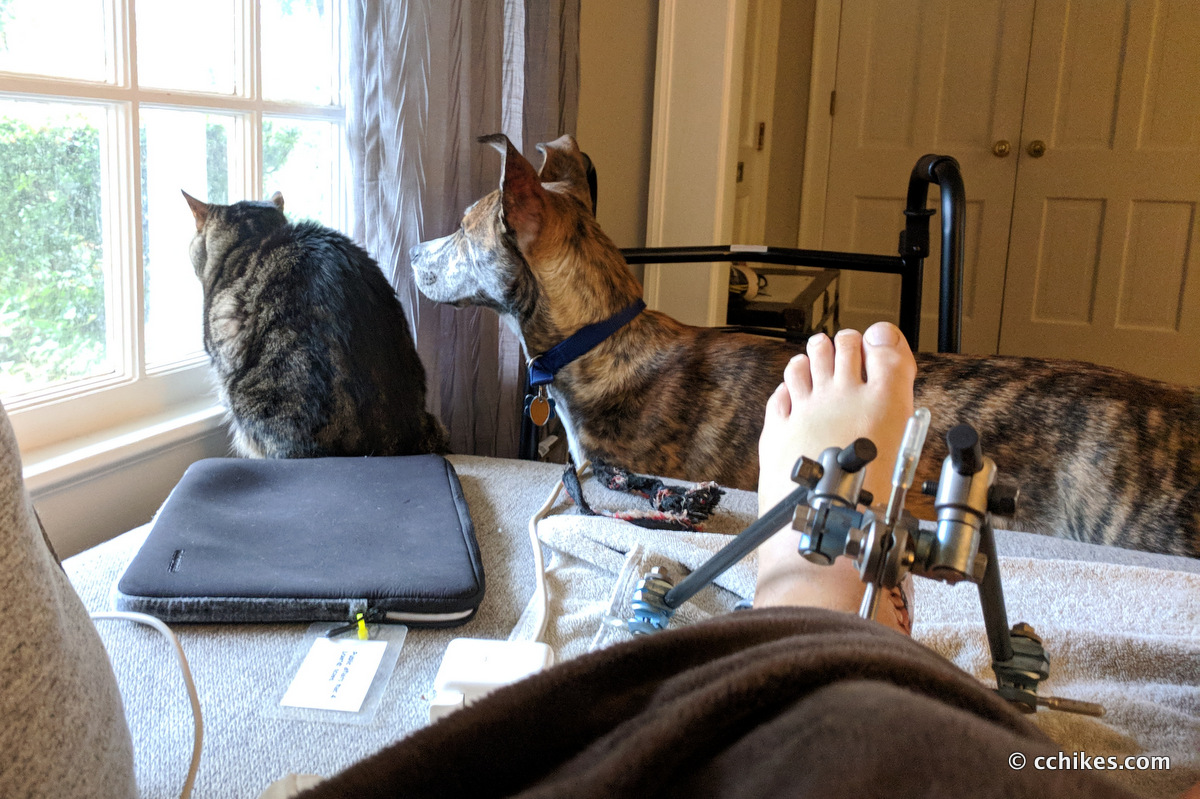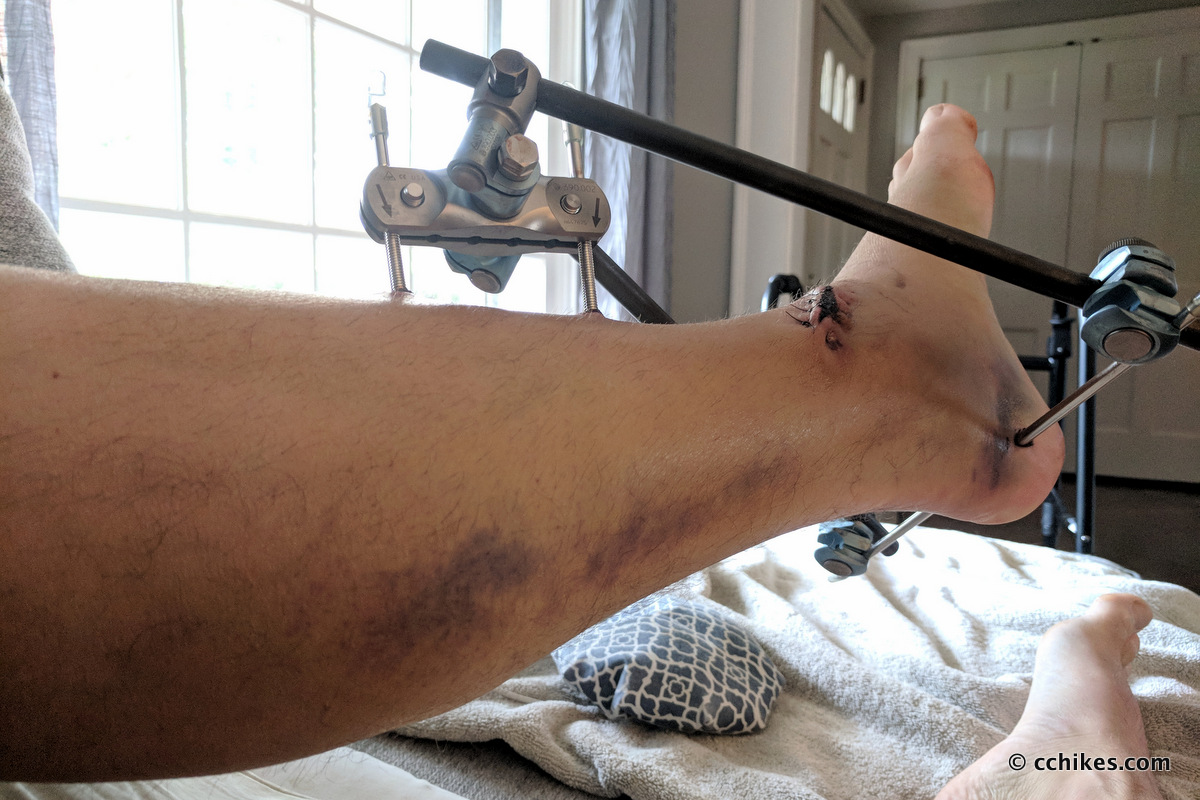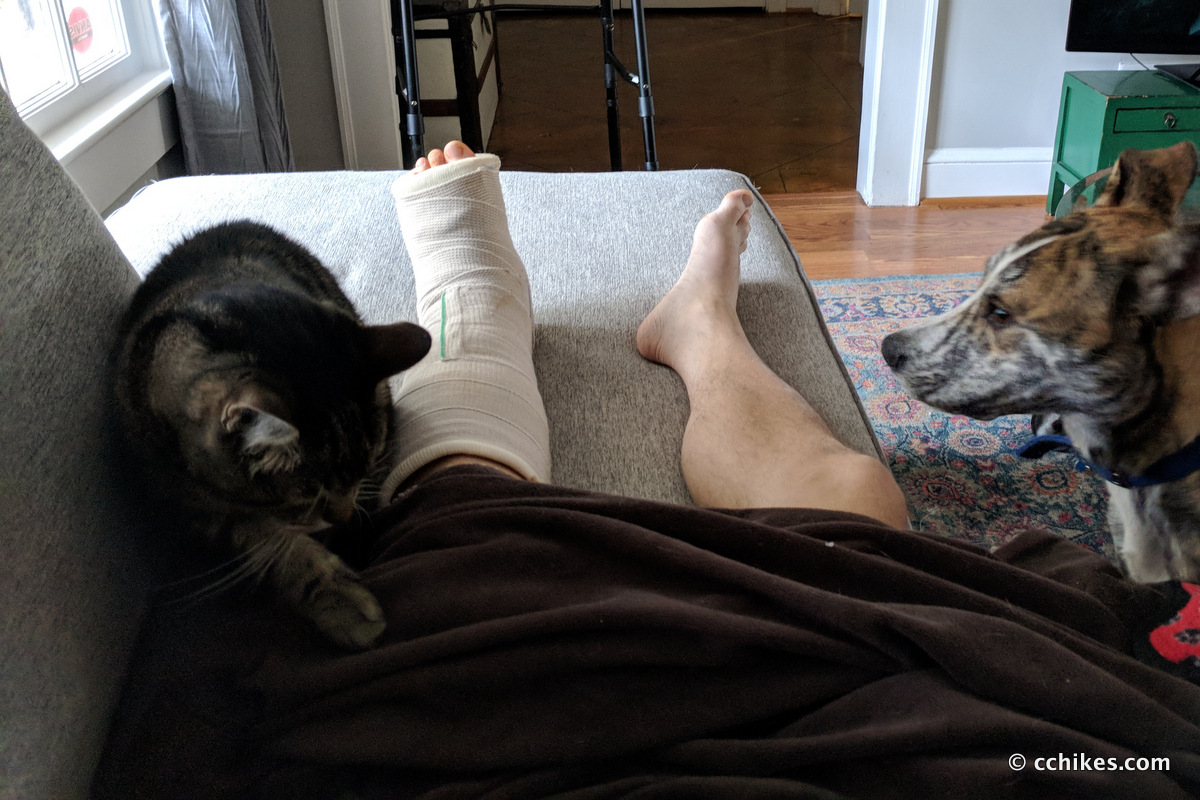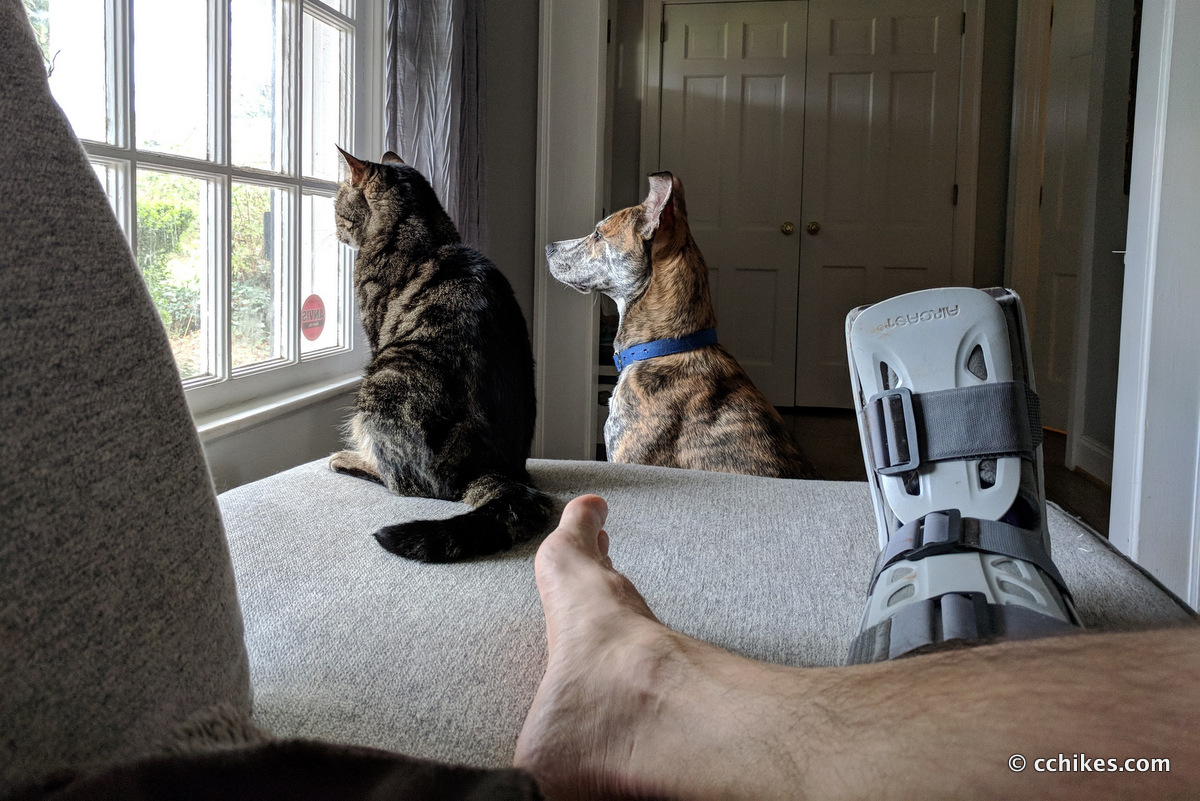If you’re reading this, then it’s only been a few minutes from part 1 to part 2. It’s been nine long months for me. Let’s start where My leg and the Linville Gorge, part 1 left off.
November 2018
If you remember, the doctors affixed me with something called an external fixation. While effective, this thing was like a medieval torture device. I lived on the couch. I had to use a walker because my right foot was so sprained that I couldn’t move it. I stabilized myself over the walker and awkwardly pushed on the ground with my right foot until I skidded forward a few inches. It was slow, grueling work.

Did you ever hit a rock with an aluminum bat when you were a kid? It turns your arm into a tuning fork. That’s a mistake you make exactly once.
Imagine that tuning fork is screwed directly into your bones. Now imagine pinging that tuning fork on the base of your porcelain toilet when you go to pee. It’s an awful feeling and it happened all the time as I awkwardly inch-wormed my way into the bathroom.
Because of the way the brace formed a triangle, I was forced to lay in the same position for weeks. I had bedsores. I guess I can add that to my list of firsts associated with this ordeal.
This is what my leg looked like just before the fixation came out. Still, it’s better to have a bruised leg than no leg at all.

After that, I had another surgery in Greenville, SC, where they removed the external fixation and installed an internal fixation. The surgeons used two plates and sixteen screws to correct my tibia and fibula breaks. I was in a soft cast for weeks more.

I work in digital marketing, so my job is 99.9% browser-based. I can work anywhere I have an internet connection. I was told not to try to come into the office while I had metal bars and screws sticking out of my skin. After that, they told me to come in only if I felt like it wouldn’t set my recovery back.
A few days after getting the soft cast, I went back to the office and pretty much resumed living a normal life as best as I could. I even hosted a Friendsgiving and had people over to watch the Iron Bowl and feast on gumbo.
By this point, my right foot had gained enough flexibility to ditch the walker and switch to crutches. It still hurt with every step, but it was worth the pain to have better mobility.
December 2018
Eventually, the sutures from the internal fixation surgery needed to come out. I went to the doctor’s office and they cut off the cast, removed the sutures, and X-rayed my leg. This was the first look I got at my repaired bones and my post-surgery skin. If you want to see what the sutures looked like, then click the link below.
WARNING: The following photo is fairly graphic, so you have to click on it to open it in a new window. If you don’t like seeing trauma, scroll down. Click here to see the aftermath of my leg surgery.
Fortunately, I was granted a removable boot rather than a hard cast. That meant I could take it off to shower and sleep and let the air start to heal the wounds. Note how pristine the boot looks. You’ll see it again later.

This is a little off-topic, but I had met my insurance deductible after my leg surgeries. So I thought, “I’m basically immobile, I’m already in pain, and I’m more or less off the hook for medical bills in 2018. Why don’t I get my hernia looked at?”
I went to another doctor and he informed me that I had two umbilical hernias that involved an out-of-position nerve. That explained the discomfort when I exercised or ate too much. They scheduled my surgery before the end of December. I went back to the hospital yet again and they sewed a rectangular piece of PVC into the back of my abdominal muscles.
The pain was severe. I remember shaking my head and thinking, “someday, this will seem like it was a good idea.”
Trying to carry your body weight on crutches with what feels like fishing line woven through your abs is very difficult. Every time I coughed or laughed or tried to sit up, I understood what Caesar must have felt like as he lay dying on the *Senate floor.
According to the book, SPQR: A History of Ancient Rome, Caesar didn’t get stabbed to death in the Senate. But it was good enough for Shakespeare and it’s good enough for me.*
Every day, the pain lessened. By the time Christmas rolled around, I endured a car ride across the southeast to visit family. I was in discomfort in my leg, foot, and torso, but it wasn’t that bad in relation to everything I’d been through.
January 2019
Not much changed in January. Eventually, my abdominal pain went away completely. I really had to contort myself to even feel the stitches.
I got more X-rays on my leg. I was hopeful that I’d be able to start putting weight on it and was crestfallen when the doctor nonchalantly remarked, “It’s looking pretty good. Come back in another month for more X-rays.”
I went to work, I ran errands, I cleaned the house, and everything else that healthy people do. Life doesn’t slow down. I even started going to the gym a couple of times a week to do some upper body exercises. But I had to walk a thin line between getting a good workout and working out so hard that I couldn’t use my crutches to get back to my car.
And I shamelessly used my injury to secure roomy, wheelchair-accessible seats for a star-studded Willie Nelson tribute concert in Nashville. ¯\_(ツ)_/¯
February 2019
I went back for X-rays and got a mixed bag of news. The bone didn’t heal much from January to February. I’d been taking my vitamins and calcium pills twice per day, but the fractures weren’t filling in. The doctor told me that the bone needed to be stressed in order for the brain to start knitting it further together. I was told to put 25% of my body weight on my injured leg for the next two weeks, and then up it to 50% until March when we’d X-ray it again.
Do you know how awkward it is to put 25% of your body weight on one leg when walking with crutches? It’s about as natural as the triple jump. How much does a leg weigh on its own? How much pressure should I add to get to 25%? Moving to 50% weight made much more sense. I could actually stand on both legs.
Another thing the doctor said bothered me. He mentioned that part of his job simply involves waiting to see what happens and then reacting. He casually remarked, “there’s a chance the tibia fracture could skid. In that case, we’ll have to open your leg back up and perform a bone graft.”
My eyebrows climbed up my forehead. My eyes must have grown to the size of silver dollars.
I had talked so big about how I was going to crush physical therapy and get my leg back in shape in time for my annual fall backpacking trip, but this really scared me. I was never planning to be reckless with my post-injury exercise, but I did want to challenge myself. Now all I wanted to do was give the bones time to heal properly—even if that meant staying on crutches through the spring.
March 2019
I went back to the doctor and finally got to sit down with the surgeon who installed my internal fixation. The man is pressed for time, so I almost felt bad when he got up to leave the room multiple times and my questions made him sit back down. He told me I could start walking again, but I would need to stay in the boot for another 3–4 weeks. Then I could lose the boot when I felt comfortable. Fine by me. I also ran a hypothetical by him.
I said, “I work better with a deadline. That would give my physical therapy a beginning and a middle and an end. Let’s imagine I’m planning a backpacking trip for late August. Would that be possible given my situation and my recovery time?”
He said, “by backpacking trip, you don’t mean 100 miles or something like that, do you?”
I tossed my head from side to side and replied, “well, what in have in mind is 175 miles. But most of the trail is mountain-bike-rated, so it’s a pretty flat and sandy pathway.”
He gave me a long stare and then assured me that my fracture would be completely healed within three months and the only concern would be discomfort and pain. I couldn’t hurt it any worse. So now I’m planning to hike the Tahoe Rim Trail in California/Nevada in fall 2019.
April 2019
After three weeks in the boot, I took it off. Walking was much more unnatural than I imagined it would be. I knew it would take some time to get back into step (pun intended), but I didn’t think I would have to fight my preservation reflexes in order to put one leg in front of the other like I’ve done all my life. I had spent so long avoiding putting weight on my leg that it felt reckless to rely on it. I had to mentally overcome the urge to limp.
The flexibility in my ankle was gone. It was like a rusty hinge that barely budged. I could walk on level surfaces, but any change in terrain made my ankle feel like it would buckle if it wasn’t swollen to the point of being too stiff to relent. For example, I could walk up the stairs, but I couldn’t walk down normally. My left foot simply couldn’t bend to lower my body down to meet the next step.
The only way forward was through normal usage. So I used it.
May 2019
When I first started walking without the boot in April, the most acute pain I felt was in my fracture areas and where my muscles and ligaments scraped against the plates and screws. It felt like a cheese grater. My tibia and fibula ached with every step. But by the time May rolled around, the muscles had stiffened around the metal and my bones mostly stopped feeling anything at all.
I went back for X-rays and the surgeon told me that my leg looked great. The bone breaks were filling in nicely and I had more flexibility in my ankle than he usually sees with his patients at this point in their recovery. The swelling I had been experiencing was normal and could take up to two years to go away. Some of it will never go away. Whatever; symmetry is overrated.
I went to a physical therapist and they quoted me $88 out-of-pocket costs per visit. So if I visited three times per week, that would be over $1000 per month. Screw that. There are things I lack in this world, but motivation is not one of them.
I started hiking again. The Whiteside Mountain loop was one of my first hikes. Then I gradually worked my way up to longer hikes like Opossum Creek Falls. The act of walking on uneven surfaces really helped to stretch my muscles, ligaments, and tendons. It also brought a new kind of pain.
I didn’t bend my ankle or toes for almost half a year. Contorting my swollen leg into new positions made me very aware of how intricate the muscular system is. I felt parts of my leg and foot that I’d never felt before. For example, I had never been sore on the tops of my toes before.
My ankle would be very stiff when I stood up, but the stiffness would work itself out after several steps. Then I could go for miles. This discomfort should go away as I gradually stretch out and rebuild my leg and foot.
Before I got hurt, I had a habit of using a treadmill a few times per week. I would start at 4.2 MPH and work my way up to around 4.6 MPH over 100 minutes. That resulted in a brisk walk that was 7 miles long and burned 1000 calories. I’m trying to work my way back to that. I’ve built my speed back up to 4 MPH, but I can only go for about 40 minutes (around 2½ miles) until the discomfort gets too bad and I have to take a break. On the weekends, I’m hitting the trails where I can actually walk farther because I go slower.
I have a final X-ray scheduled for July. I’m hoping to have my ankle back to full flexibility by then and be near or back to my old workout routine. I’m feeling pretty good these days—both physically and mentally. This has been a long journey, but I’m almost out of the tunnel and back into the light.
June 2019
Due to some unforeseen circumstances with my living situation and some luck with my girlfriend being able to transfer her job, we decided to move to Colorado. Sadly, all of the transition involved with relocation required me to push my Tahoe Rim Trail thru-hike back to fall 2020. Oh, well.
(Update: The pandemic forced me to push my 2020 TRT hike back even further)
I had started regaining some flexibility in my left ankle and noticed that my right foot was hurting as badly as my left. I called the doctor and he squeezed me in before my move date. Since he was going to X-ray my left leg, I asked him to scan my right foot as well. It turns out that I suffered a stress fracture in the middle of that foot during the accident. The doctor asked me if I still had the plastic boot and I told him that I did. He instructed me to slap it on my right leg after the move and wear it for 4 weeks.
July 2019
I hiked all over Golden, Boulder, and the Rocky Mountains in that boot. When I finally ditched it, it was falling apart.
Next, I inserted a carbon fiber plate into my right shoe to minimize the flex in my arch. I was instructed to wear it for at least six weeks or longer if the pain persisted. But that was barely an inconvenience.
My left ankle had regained about 85% flexibility, my right foot was barely hurting anymore, and I was feeling strong.
August 2019
I’m back, baby.
What a humbling experience this has been. I may be physically weaker than before the accident, but I’m mentally and emotionally stronger. It’s been a year of change. And you know what they say; there’s opportunity in change. I’m looking forward to taking advantage of those opportunities.
I’m in a new place in a new city in what feels like a new body. I’ve spent enough time on the couch. I’m ready to get out and explore. And you’re invited to follow along!










David L Terrie
Chad,
That was one gnarly injury. Sorry for the pain. I’m familiar with it. I had knee replacement surgery on 12/4/18. The first 5-6 weeks were brutal. Three months out now from surgery and planning to hike the Big SEKI Loop this fall. I go solo, but carry an InReach. Good luck with the TRT. It’s good to have goals.
Chad Chandler
Thanks, David. Best of luck with your hike!
I’m going to lose a little weight in March and April and then spend the rest of spring and summer bulking with protein powder breakfasts. I’m hoping to get my muscles, agility, and confidence (I don’t trust my left ankle at all) back to where they were before the accident.
Rhae Sutphin
David,
I love you posts! I broke my talus bone and it took 2 years to get back to normal! I too said the same words..as long as I can hike with a prosthetic I will be okay! I am not a writer so to read my thoughts and agony on your page was amazing! My daughter also had a freak ankle accident and her break is very similar to yours affix and all. She said it was hard to read this as the memory of the pain is real.
Hope you are doing well. Keep hiking! Check out http://www.29029.com I did this after my recovery
Jeff
David,
One of my good friends was one of the trail angel’s that helped you get out of the Gorge. He and his wife were the ones that brought your vehicle to you and he help carry you to the paramedics.
I live in NC and hike the Gorge almost exclusively every year. I have been hiking and packing in LGW for over 20years. My 1st trip in we were unprepared and unqualified to be there and almost died. Since then have redeemed Linville Gorge a 100 times over.
In 2017 I got both of my knees replaced and set out to thru hike the AT. I left 15 weeks post surgery and can totally relate to your pain and frustration with healing.
During 2020 I started planning a backpacking guide business and decided to make it exclusively for the Gorge. I just think people really need to get out test themselves and experience something special like LGW.
My buddies and I recently started planning for the backpacking season and Gabe brought up your name and story as we are planning on doing the loop in October.
I’m sharing all this with you because I want to see if we may be able to mutually benefit each other in advice, promotion, even empathy.
I’m not sure where you are or what you are doing these days, but if you have any interest in chatting, I would love to hear from you.
Much respect to you and your journey. Hiking you own hike sure as hell ain’t easy.